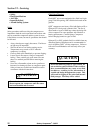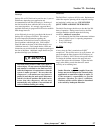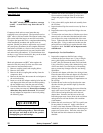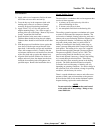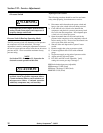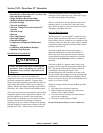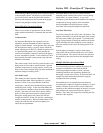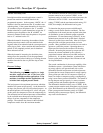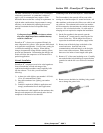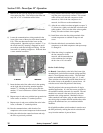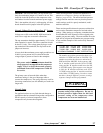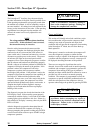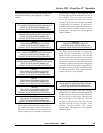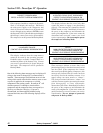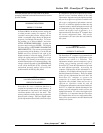
Section VIII - Power$ync II
™
Operation
34 Quincy Compressor
®
- QSD™
The differential between the load pressure and the unload
pressure cannot be set to less than 5 PSIG. At the
maximum setting for both load and unload pressures, the
differential will be 15 PSIG. At the minimum load
setting (75 PSIG) and the maximum unload setting (125
PSIG, for example), the differential can be great.
To determine the proper pressure and differential
settings, several factors must be considered. The first
consideration is the actual pressure required in the plant
air distribution system to maintain proper equipment
performance. For maximum energy efficiency, do not
maintain more pressure in the system than is required.
Almost all systems have some leaks. More air will pass
through a leak at a higher pressure than at a lower
pressure. Many pneumatic tools and devices are rated to
operate at a particular pressure. Operating them at a
higher pressure increases the amount of air that they
consume. Increasing the pressure by ten percent will
increase the volume consumed by the system by a
proportional amount without an associated increase in
productivity. It is prudent, therefore, to maintain the
lowest system pressure that provides efficient tool and
device performance.
The second consideration is the storage capability of the
distribution system. A distribution system with little or
no storage capacity will operate better with a wider
differential between load pressure and unload pressure.
Systems that have more compressed air storage capacity
(three gallons per cubic foot of compressor capacity or
better) can improve compressor energy consumption by
using a more narrow pressure differential. The benefit of
having adequate storage capacity is a more consistent
system pressure and smoother operation of equipment.
The differential should be initially set at 15 PSIG. If the
system pressure remains steady throughout a typical work
cycle, the differential can be reduced to as low as 5 PSIG.
If the system pressure fluctuates greatly at 15 PSIG,
indicating little system storage capacity, the differential
may need to be broadened.
Network Load Delay Time
In multiple machine network applications, control is
passed from machine to machine based on the
programmed sequence. In the sequence ‘ABCD’, the ‘A’
machine is the base machine and the ‘D’ machine starts
with the pointer. If the system demand for air drops, the
‘D’ machine will pass the pointer to the ‘C’ machine.
Further reductions in system demand may trigger the ‘C’
machine to pass the pointer to the ‘B’ machine. An
increase in demand would cause the pointer to be passed
back to ‘C’ and then back to ‘D’.
When the demand is decreasing, the machine with the
pointer passes that control to the next machine in the
sequence when it has unloaded and the system pressure is
still trying to climb. After a machine has transferred the
pointer, it will completely unload, start its shutdown
timer and turn itself off.
When the demand is increasing, the load delay time
setting allows the controller to wait the programmed
number of seconds before loading up, or starting the next
machine down the list due to a pressure drop of short
duration.
Pressure Settings
NOTE
The following explanation applies to single
machine applications and to the base load
machine in multiple machine applications. Trim
machines, in multiple machine applications, will
be held to their assigned pressure bands.
The load pressure is the maximum pressure at which the
machine will operate at full capacity. As the demand for
air drops, the pressure will rise to the unload pressure. At
the unload pressure, all Power$ync II
™
valves will open.
At this point, the compressor will not be compressing air.
The maximum load and unload pressures are determined
by the available motor horsepower and the pressure
ratings of various components in the compressor
package. The technical data sheets for the individual
compressor models show this maximum number.



